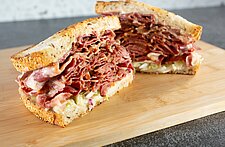Symrise hosted a private roundtable discussion featuring some of San Francisco’s most prominent names in the food and beverage industry: Chef Mourad of Mourad, Chef Chris Cosentino of Cockscomb, Chef Val M. Cantu of Californios, and Bartender/Owner Alicia Walton of Sea Star. Moderated by Symrise's Vice President of Marketing & Consumer Insights, Emmanuel Laroche, the panel delved into the topic of inspiration—where chefs these get it and how it affects their work—offering insights into the creative world of food and drinks.
Kicking off the conversation with a question about where the chefs find inspiration, they all cited the obvious sources—what looks great at the farmers market, what other chefs are posting on Instagram, even art and music. But as the conversation progressed, a more surprising, yet still common source of inspiration surfaced: The past.
For Chris Cosentino, history is a clear and present driver of his menu at Cockscomb, which he calls “a celebration of San Francisco’s diverse culinary heritage.”

“San Francisco and the West Coast are the melting pot of the US,” Cosentino says. “They screamed ‘Gold!’ and an influx of immigrants came, and they brought all of their food culture and history with them.” Cosentino’s goal is to celebrate that history by reviving, reworking, and sometimes completely reinventing dishes that were enjoyed by those early San Franciscans.
Asked specifically how he finds inspiration, Cosentino replies, “For me, the best thing to do is go to the Tonga Room at the top of California Street and walk the halls reading all of the antique menus. Just that hallway is worth millions of hours in the library.
For more culinary trends, CLICK HERE to subscribe to the weekly in-sight newsletter!
As an example of how this multicultural history informs Cockscomb’s menu, he points to his “French onion soup.” Catherine de Medici’s French chefs originally adapted a popular Tuscan soup, called carabaccia, made of potatoes, caramelized onions, and cinnamon simmered in a vegetable broth thickened with day-old bread and flavored with scraps of cheese. It was peasant food. The French chefs transformed it into the dish we know today—a rich beef broth loaded with caramelized onions and topped with a slab of crusty bread layered with molten Gruyere cheese. Later this became a popular dish in San Francisco, when French food was considered the food of the wealthy, those who had struck gold. At Cockscomb, Cosentino serves his version of French onion soup, which harkens back to the original carabaccia with a slightly sweet vegetable broth loaded with potatoes and caramelized onions and spiced with cinnamon.
“People say, ‘Oh, I know French onion soup, but I’ve never had it this way,’” Cosentino says. “So, we’re creating a comfort zone with history.”
Mourad looks to his own personal history for inspiration, calling on memories from his childhood in Morocco and putting a modern twist on them so that they “make sense” in this environment.
“For me,” Mourad says, “when I want to put a new dish on the menu, it has to come from an idea that I was exposed to back home in Morocco.” Whether that’s a dish that he remembers eating as a child or just a combination of flavors that’s stuck in his head, he combines that idea with his current environment, with the help of his diverse kitchen staff, to see what he comes up with.
CLICK HERE to view the Top Food and Beverage Trends for 2017
“There is more than one source for inspiration,” Mourad says. Whether it’s the environment, his own imagination, his staff or other people he admires, a piece of art, or seeing what others are doing on social media, the ideas come from asking, “How can I use this to tell my story?”
Val Cantu agrees. “What Mourad and I do isn’t all that different,” he says. “You have to ask yourself, how can we highlight this ingredient to really make it come through in our own voices and make it really delicious?”
“I have an advantage and Val has an advantage,” Mourad says. “Val is telling his own story about Mexican food that no one else can tell. I’m doing the same thing with Moroccan food.” But, Mourad warns, you have to put the food into the current context or environment for it to resonate with diners.
“When I came to America, I tried to duplicate the dishes that I had in morocco, but they didn’t make sense,” he says. “We used to do couscous, for example, and boil all the vegetables with the broth and they would become mush and we would pile it on the couscous. In morocco, it tastes beautiful, but here it doesn’t make any sense.”
Mourad explains that in Morocco, couscous is often served on religious holidays. “And the old people,” he says, “they have no teeth, so it’s mushy. They can eat it and it’s so beautiful. It makes sense back home.”
Another dish that needed some translation was chicken tagine. “In morocco, you take a chicken, cut it up, put it in a pot with onions, spices, and olives. And then you cook it for like 2 ½ hours. For some reason, chicken takes a lot longer to cook in Morocco than here,” he jokes. It turns into a beautiful stew, but the emphasis isn’t so much on the meat as it is on the sauce and the bread that you eat with it. “When I came to America and had roasted chicken for the first time, I was blown away. I said, ‘How come our chicken doesn’t taste like this?’”
For the restaurant, Mourad imports the idea behind this classic Moroccan chicken dish, but adapts it to fit the environment. “I take all the spices, all the flavors that are in our chicken tagine in Morocco, and I put them into a brine for the roast chicken. So, I merge both worlds together.”

“I think the interesting thing with Mexican cuisine in the US,” Cantu says, “is that it evolved to appeal to Anglo consumers as opposed to being an authentic cuisine. A crispy taco is inauthentic, but it’s delicious. It’s a conundrum. You want to appeal to those traditional flavors, but you also want to push the envelope.” Cantu also draws on flavor memories, but having grown up witnessing the bastardization of Mexican food in the US, he rejected many of the standard ingredients we expect from Mexican cuisine.
“I started incorporating ingredients from other cuisines,” he says, “and people asked, ‘How is this Mexican?’ Well, it’s because I made it and I’m Mexican. I’m trying to create cuisine that is unique to me, to this restaurant, to the city of San Francisco, and so whether you think it’s Mexican food or not, I don’t really care. You can say you don’t think it’s Mexican, but you can’t say it’s not mine.”
All of the chefs agree that understanding where you come from, where the food comes from, is key creating innovative dishes.
“I’m a firm believer in understanding history before you try to create the future,” Cosentino says.
For more information on how you can participate in Symrise Starchefs Roundtables CLICK HERE




